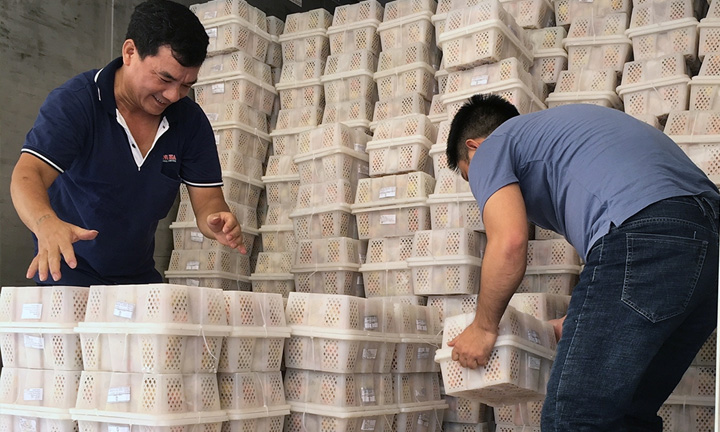SOURCE: Luciana Viegas, IAEA
“Irradiated for freshness” written across a juicy mango may raise some eyebrows, but the label has guaranteed Viet Nam exports worth US$20 million a year to the United States. Using irradiation to disinfest fruit is gaining traction in the premium produce trade, and Viet Nam, with the help of the International Atomic Energy Agency (IAEA) and the Food and Agriculture Organization of the United Nations (FAO), now plans to expand the service to compete in additional markets.
Food irradiation has been used for decades to disinfect and extend the shelf life of commodities such as spices, dried herbs and vegetable seasoning. If the products are not treated, pests can lodge in produce and hitch a ride abroad through trade, potentially causing damage to the local food production and the environment as they multiply and spread in the destination country.
“We use food irradiation because this technology can reduce food loss and facilitate agricultural exports,” said Hoang Trung, Director General of Viet Nam’s Plant Protection Department. Such exports include ‘exotic fruits’ such as mango, dragon fruit, and litchis, mostly to the United States, as well as fresh and frozen shrimps and oysters.
There are hundreds of facilities worldwide that use radiation in a variety of applications, and at least 60 use it for food irradiation. They apply low levels of radiation to kill microorganisms that may spoil food, such as bacteria or fungi. Low level radiation also prevents insects from being able to reproduce.
Ensuring produce is free of certain pests through such phytosanitary treatment is a prerequisite for global trade, especially in fresh fruits and vegetables. The detection of a single Mediterranean fruit fly in a produce container, for example, can lead to immediate import bans and devastating financial consequences for exporting countries. Other treatment methods include fumigation with chemicals, which may leave residues that are harmful to people and the environment, or heat treatment, which can alter taste and texture. Irradiation using low dose gamma rays, electron beams (E-beams) or X-rays can treat a large batch of food without loss in quality and with no risk to the consumer.
The IAEA has supported the development of irradiation as a phytosanitary treatment for decades through its technical cooperation programme, but the method has been slow to take off in the commercial fruit market, as industry players often perceive a potential backlash from consumers. This has changed in recent years, says Carl Blackburn, Food Irradiation Specialist at the Joint FAO/IAEA Programme for Nuclear Techniques in Food and Agriculture, as consumers embrace the all-year-round availability of “beautiful and tasty fruits” free from chemicals or a heavy environmental cost.
Major fruit exporting countries, such as India, Thailand and Viet Nam, are using food irradiation, as well as countries such as the United States, Australia and New Zealand, which rely on the method to ensure the safety of imported produce.
“Irradiation is gentle on the fruit but not on the pest,” says Blackburn. “The treatment is optimized to neutralize pests while retaining most nutrients and having least impact on flavours, textures and colours.”
Experts in Viet Nam began research on food irradiation in the late 1990s with IAEA support, and the country now counts 11 facilities. Gamma rays are most commonly used and can treat around 1 tonne of fruit per hour. Last year an average of 200 tonnes of fresh export fruits were irradiated per week in Viet Nam using gamma and X-rays.
This year, one Vietnamese irradiation centre received approval to treat 100 tonnes of fresh litchis for export to Australia, and the country is now planning to expand services to treat passion fruits and pomelos, as well as vegetables and frozen seafood for export and domestic consumption.
Many countries have expressed interest in food irradiation for fruits, but a bottleneck according to Blackburn is capacity, or having enough irradiation services. “We know there is a need, but seasonal fresh fruit is competing with indusdtrial goods and medical equipment that are routinely irradiated all-year-round in a facility.”
E-beams for increasing application of irradiation
Using radiation generated by electricity, such as E-beams, and advances in the technology itself could make the process cheaper and easier, says Blackburn. Unlike gamma rays from radioactive sources, E-beams and X-rays can be switched on for use only when the fruit is in season, making the process more cost effective. They also reduce safety and security concerns associated with the use of radioactive sources. Viet Nam plans to move towards building new E-beam and X-ray irradiation facilities.
Portable irradiation devices could further increase the commercial appeal of the method, as these could be directly used at a fruit factory packing line. “Right now, you have to take the food to an irradiation facility but in the future, we hope to bring the irradiation to the food, as part of normal operations,” said Blackburn. Such portable E-beam devices are the size of a small car and are already being tested to irradiate spices in some countries.
The IAEA, in cooperation with FAO, helps countries in the use of nuclear techniques to improve food safety and increase agricultural productivity and sustainability in various ways.

